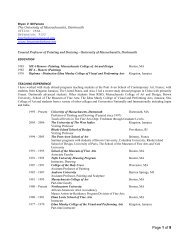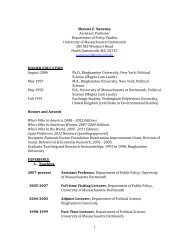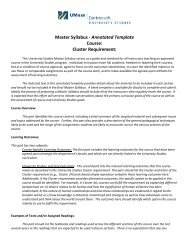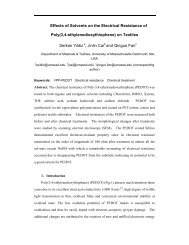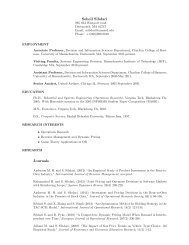Together at Last: Reading the Love Letters of Ophelia Queiroz and ...
Together at Last: Reading the Love Letters of Ophelia Queiroz and ...
Together at Last: Reading the Love Letters of Ophelia Queiroz and ...
- No tags were found...
Create successful ePaper yourself
Turn your PDF publications into a flip-book with our unique Google optimized e-Paper software.
230 Anna M. Klobuckaacldressed ophelia: 'o d.ear ophelia, I am ill <strong>at</strong> <strong>the</strong>se numbers, I have notart to reckon my groans, but th<strong>at</strong> I love <strong>the</strong>e best, o most best, believe it.'I felt extremely agit<strong>at</strong>ed, as is only na[ural, <strong>and</strong>, not knowing wh<strong>at</strong> to say,' I finished putting on my co<strong>at</strong> <strong>and</strong> rapidly said good bye. Fern<strong>and</strong>o got up,oil lamp in h<strong>and</strong>, to accompany me to <strong>the</strong> door. But <strong>the</strong>n, suddenly, he set<strong>the</strong> lamp down on top <strong>of</strong> a low wall <strong>and</strong> unexpectedly seized me by <strong>the</strong>waist, embraced me <strong>and</strong>, without a word, kissed me, kissed me passion<strong>at</strong>ely,like a madman ...I went home ashamed <strong>and</strong> confused. Days went by <strong>and</strong> since Fern<strong>and</strong>omade no reference to wh<strong>at</strong> had happened between us I decided to wdtehim a letter asking for an explan<strong>at</strong>ion. Th<strong>at</strong> is wh<strong>at</strong> gave origin to his firstletter, <strong>the</strong> response d<strong>at</strong>ed March 1, 1920. And so our'courtship' began.]This exceedingly dram<strong>at</strong>ic scene, occurring literally on a d,arkened.stage, with meticulous marking <strong>of</strong> <strong>the</strong> actors' movements (I was st<strong>and</strong>ing,he s<strong>at</strong> down, he stood up), no less meticulously described use <strong>of</strong>props (<strong>the</strong> note, <strong>the</strong> oil lamp, <strong>the</strong> co<strong>at</strong>), <strong>and</strong> <strong>the</strong> Hamlet-<strong>Ophelia</strong> Iovescene met<strong>at</strong>he<strong>at</strong>rically embedded <strong>at</strong> its climax, has been cited by criticssuch as Seabra as one pro<strong>of</strong> among many th<strong>at</strong> Pessoa staged his affairwith ophelia as an episode in <strong>the</strong> ongoing production <strong>of</strong> his heteronymousdrama em gente. However, <strong>the</strong> scene reproduced above was, after all,narr<strong>at</strong>ed by <strong>Ophelia</strong> <strong>and</strong> written down - 'collected,' 'compiled,' <strong>and</strong>'structured'- by her gre<strong>at</strong>-niece: <strong>at</strong> <strong>the</strong> very least, it can be observed th<strong>at</strong><strong>the</strong>y took <strong>the</strong> element <strong>of</strong> Shakespearean inspir<strong>at</strong>ion supplied by <strong>the</strong> poet<strong>and</strong> ran with it, constructing'a fully developed work <strong>of</strong> dram<strong>at</strong>ic fictionth<strong>at</strong> has, in turn, shaped <strong>the</strong> scene <strong>of</strong> critical interpret<strong>at</strong>ion <strong>of</strong> <strong>the</strong> affairfor decades to come." Th<strong>at</strong> <strong>the</strong> two <strong>Queiroz</strong> women may have engagedin something more coinplex than passively reflective acts <strong>of</strong> recollection<strong>and</strong> transcription did not, however, become fully apparent until <strong>the</strong> public<strong>at</strong>ion<strong>of</strong> Opheiia's letters (to which she had no access since writing <strong>and</strong>sending <strong>the</strong>m in <strong>the</strong> first place, <strong>and</strong> <strong>the</strong>refore could not refer to her owndocument<strong>at</strong>ion <strong>of</strong> <strong>the</strong> rel<strong>at</strong>ionship, much more detailed <strong>and</strong> comprehensivethan th<strong>at</strong> contained in Pessoa's contribution to <strong>the</strong> correspondence).For <strong>the</strong> letters tell a r<strong>at</strong>her different story <strong>of</strong> <strong>the</strong> early stages <strong>of</strong><strong>the</strong> courtship: while confirming th<strong>at</strong> <strong>the</strong> famous quasi-Shakespeareanlove scene with its crucial first kiss did in fact occur - since in one <strong>of</strong> herl<strong>at</strong>er missives <strong>Ophelia</strong> refers to an anniversary <strong>of</strong> <strong>the</strong> 'performance <strong>of</strong>Hamlet' as <strong>the</strong> 'first time my mouth touched your ,norrth' - <strong>the</strong>y alsorevealed th<strong>at</strong> it took place on Z2January 1920, <strong>and</strong> <strong>the</strong>refore not d.aysbut well over a month before ophelia wrote to Fern<strong>and</strong>.o dem<strong>and</strong>ing a<strong>Love</strong> <strong>Letters</strong> <strong>of</strong> <strong>Ophelia</strong> <strong>Queiroz</strong> <strong>and</strong> Fern<strong>and</strong>o Pessoa 231st<strong>at</strong>ement <strong>of</strong> his intentions, <strong>and</strong> th<strong>at</strong> in those intervening weeks <strong>the</strong>irlove affair had gained considerable momentum.l8 In o<strong>the</strong>r words, <strong>the</strong>nineteen-year-old <strong>Ophelia</strong> was not such a stern paragon <strong>of</strong> respectabilityas her much l<strong>at</strong>er account implies; it was only after several months <strong>of</strong>flirting <strong>and</strong> a fewweeks <strong>of</strong> physical intimacy (limited, to be sure, to kisses<strong>and</strong> embraces <strong>at</strong> <strong>the</strong> <strong>of</strong>fice) th<strong>at</strong> <strong>the</strong> young woman became exasper<strong>at</strong>edwith <strong>the</strong> secret <strong>and</strong> undefined n<strong>at</strong>ure <strong>of</strong> her workplace romance <strong>and</strong>chose to take initi<strong>at</strong>ive towards determining its long-term prospects.It is indeed fitting th<strong>at</strong> <strong>the</strong> correspondence between Pessoa <strong>and</strong>ophelia began <strong>the</strong> way it did, since <strong>the</strong> two inaugural letters - hers <strong>and</strong>his - anticip<strong>at</strong>e <strong>and</strong> epitomize its fur<strong>the</strong>r development. <strong>Ophelia</strong>'s openinggambit is a mention <strong>of</strong> her convers<strong>at</strong>ion with an ex-boyfriend who is' still devoted to her <strong>and</strong> desires to win her back:Estpu desprez<strong>and</strong>o um rapaz que me ad.ora, que me faria felize que eu seimuito bem as ideias d'ele para mim ... E diga-me agorafrancamente, sei eualguma coisa do Fern<strong>and</strong>inho?Jd alguma vez me disse as suas ideias, o quepensa fazer de mim? ... Nao me tenho eu entregado completamente ao meuFern<strong>and</strong>inho? Que recompensa rne dar6? ... Se o Fern<strong>and</strong>inho nunca pensouem construir famflia, e se nem pensa, peqo-lhe por tudo ... que mo digapor escrito, que me diga as suas ideias sobre a minha pessoa (e nlo seesqueqa que tem dito muitas vezes que me ndo ama, que me adora!)le[I am rejecting a man who ad.ores me, who would make me happy <strong>and</strong>whose plans for me I know very well ... And tell me frankly now, wh<strong>at</strong> do Iknow <strong>of</strong> you, Fern<strong>and</strong>inho? Have you ever told me your ideas,. wh<strong>at</strong> youplan to do with me? ... Haven't I given myself completely ro my Fern<strong>and</strong>inho?And how will he recompense me for it? ... Fern<strong>and</strong>inho, if you nevercontempl<strong>at</strong>ed starting a family, <strong>and</strong> if you don't have such plans now, Iimplore you ... to tell me in writing wh<strong>at</strong> your ideas for me are (<strong>and</strong> don'tforget th<strong>at</strong> you have told me many times th<strong>at</strong> you don'tjust love me, th<strong>at</strong>you adore me!)lNow for Fern<strong>and</strong>inho's reply:Para me mostrar o seu desprezo, ou, pelo menos, a sua indiferenqa real, nd.oera preciso o disfarce transparente de um discurso t6o comprido ... euemama verdadeiramente nio escreve cartas que parecem requerimentos deadvogado. O amor nio estuda tanto as cousas, nem tr<strong>at</strong>a os outros comoreus que 6 preciso 'entalar' ... Reconheeo que tudo isso 6 c6mico, e que a
232 Anna M. Klobuckaparte mais c5mica disto tudo sou eu. Eu pr6prio acharia graea, se ndo aamasse tanto, e se tivesse tempo para pensar em outra cousa que nlo fosseno s<strong>of</strong>rimento que tem prazer em causar-me ...Ai fica o 'documento escrito' que me pede. Reconhece a minha assin<strong>at</strong>urao tabelilo Eugdnio Silva.2o[You could have shown me your contempt, or <strong>at</strong> least your supreme indifference,without <strong>the</strong> see-through masquerade <strong>of</strong> such a lengthy tre<strong>at</strong>ise ...Those who really love don't write letters th<strong>at</strong> read like lawyers' petitions.<strong>Love</strong> doesn't examine things so closely, <strong>and</strong> it doesn't tre<strong>at</strong> o<strong>the</strong>rs likedefendants on trial ... I realize th<strong>at</strong> all this is comical, <strong>and</strong> th<strong>at</strong> <strong>the</strong> mostcomical part <strong>of</strong> it is me. I myself would think it was funny if I didn't love youso much, <strong>and</strong> if I had <strong>the</strong> time to think <strong>of</strong> anything besides <strong>the</strong> suffering youenjoy inflicting on me ...Here's <strong>the</strong> 'written document' you requested. The notary Eug6nio silva canvalid<strong>at</strong>e my sign<strong>at</strong>ure.l 2l\44r<strong>at</strong> st<strong>and</strong>s out above all else in this initial exchange is <strong>the</strong> ,he said,she said' miscommunic<strong>at</strong>ion <strong>and</strong> crossing <strong>of</strong> purposes between <strong>the</strong> twolovers: ophelia's unexceptional desire to domesticute <strong>and</strong> normalize<strong>the</strong>ir romance by channelling it into engagement <strong>and</strong> marriage - <strong>the</strong>only possible development for a young woman from a respectable, middle-classPortuguese family <strong>of</strong> her time, as both ophelia <strong>and</strong> Fern<strong>and</strong>oknew very well - clashes with <strong>the</strong> confused <strong>and</strong> confusing non-sequitur <strong>of</strong>Pessoa's reply, in which we can detectjealousy <strong>and</strong> injured pride <strong>at</strong> beingexamined side by side with ophelia's ex-boyfriend, bur also a perplexinglack <strong>of</strong> underst<strong>and</strong>ing <strong>of</strong> wh<strong>at</strong> was, in <strong>the</strong> historical time inJ socialmilieu <strong>the</strong>y shared, an entirely predictable expect<strong>at</strong>ion. In effect, it ispossible to read this exchange as a textbook case <strong>of</strong> Deborah Tannen,slinguistic investig<strong>at</strong>ions into <strong>the</strong>'cross-cuitural communic<strong>at</strong>ion' betweenmen <strong>and</strong> women <strong>and</strong> an apt sample <strong>of</strong> <strong>the</strong> distinct ,genderlects' <strong>of</strong> <strong>the</strong>two sexes clashing dialogically in a historically specific time <strong>and</strong>. place.22The question <strong>of</strong> marriage would remain <strong>at</strong> <strong>the</strong> forefront <strong>of</strong> fur<strong>the</strong>rcorrespondence, although Pessoa himself made only rare, mostly indirectreferences to <strong>the</strong>ir possible future life toge<strong>the</strong>r, while <strong>Ophelia</strong> seizedevery opportunity to <strong>at</strong>tempt to extract a more binding declar<strong>at</strong>ion,going as far as to sign some <strong>of</strong> her letters 'ophelia eueirozpessoa' (fol_lowed by 'I wish' in paren<strong>the</strong>ses) <strong>and</strong> sending Fern<strong>and</strong>.o postcards <strong>of</strong>babies she would describe as 'o nosso Fern<strong>and</strong>inho pequenino de aigumdia' (our future little Fern<strong>and</strong>inho). she also <strong>at</strong>tempted to transflrm<strong>Love</strong> <strong>Letters</strong> <strong>of</strong> <strong>Ophelia</strong> <strong>Queiroz</strong> <strong>and</strong> Fern<strong>and</strong>o Pessoa 233her metaphysics <strong>of</strong> wishful thinking into a politics <strong>of</strong> faits accomplis bysuggesting th<strong>at</strong> she might tell her sister Fern<strong>and</strong>o had already asked forher h<strong>and</strong> in marriage in order to dispose her family more favourablytowards <strong>the</strong>ir continuing courtship..Pessoa, with very rare exceptions,tended to ignore those <strong>and</strong> o<strong>the</strong>r hints: to give but one example, when<strong>Ophelia</strong> wrote him repe<strong>at</strong>edly <strong>and</strong> <strong>at</strong> considerable length about a convenientlypriced <strong>and</strong> loc<strong>at</strong>ed apartment th<strong>at</strong> had become available for rent,he chose to ignore her <strong>at</strong> first implied <strong>and</strong> eventually explicit message -th<strong>at</strong> it would be perfect for <strong>the</strong> fwo <strong>of</strong> <strong>the</strong>rn - <strong>and</strong> answered only heroriginally st<strong>at</strong>ed query about its precise distance from <strong>the</strong> street in whichhe was <strong>the</strong>n living with his mo<strong>the</strong>r <strong>and</strong> sister.23The recurrently foregrounded question <strong>of</strong> marriage th<strong>at</strong> forms <strong>the</strong>sustaining backbone <strong>of</strong> <strong>the</strong> correspondence (expressing itself throughinsistent redundancy in <strong>Ophelia</strong>'s letters <strong>and</strong> through elliptical circumnavig<strong>at</strong>ionin Fern<strong>and</strong>o's) allows us to posit, in addition to <strong>the</strong> overtShakespearean parallel, ano<strong>the</strong>r fictional model th<strong>at</strong> may be taken as acorrel<strong>at</strong>ive <strong>of</strong> <strong>the</strong>ir epistolary rel<strong>at</strong>ionship. The Pickwick Papers - Pessoa'sall-time favourite work <strong>of</strong> narr<strong>at</strong>ive fiction - <strong>and</strong> o<strong>the</strong>r early novels byDickens launched <strong>the</strong> archetypal p<strong>at</strong>tern <strong>of</strong> Victorian fiction by making<strong>the</strong> 'happily-ever-after' <strong>of</strong> <strong>the</strong>ir <strong>of</strong>ten multiple conjugal denouements <strong>the</strong>cornerstone on which 'a protective alliance <strong>of</strong> domestic harmony <strong>and</strong> arefuge from <strong>the</strong> world.'s evils' is founded .24Yet, <strong>at</strong> <strong>the</strong> same time, <strong>the</strong> contrastinggynephobic <strong>and</strong> utopian homosocial dimension <strong>of</strong> The PichwichPapns - an aspect <strong>of</strong> <strong>the</strong> novel to which Pessoa was highly sensitive, asnoted in <strong>the</strong> introduction to <strong>the</strong> present volume - gener<strong>at</strong>es resistanceagainst <strong>the</strong> coercive social <strong>and</strong> moral authority <strong>of</strong> <strong>the</strong> marriage plot. In ananalogous fashion, resistance against <strong>Ophelia</strong>'s conjugal designs isembodied, within hers <strong>and</strong> Fern<strong>and</strong>o's epistolary dialogue, by recurrentevoc<strong>at</strong>ions <strong>of</strong> <strong>the</strong> queerest <strong>of</strong> Pessoa's heteronyms. <strong>Ophelia</strong>'s unwaveringdislike <strong>of</strong> Avaro de Campos <strong>and</strong> his presumable aversion towards her(affirmed, albeit occasionally also denied, by Pessoa) form one <strong>of</strong> <strong>the</strong> leitmotifs <strong>of</strong> <strong>the</strong> correspondence <strong>and</strong>, without explicitly intersecting withreferences to marriage, produce never<strong>the</strong>less a p<strong>at</strong>tern <strong>of</strong> triangularnegoti<strong>at</strong>ion <strong>of</strong> purposes <strong>and</strong> desires. <strong>Ophelia</strong> generally rebuts Alvaro'sencroachments, declaring, for instance, th<strong>at</strong> she will not voluntarilyreceive.him in her <strong>and</strong> Fern<strong>and</strong>o's home .25 On one occasion, however,she appears sufficiently resigned to <strong>the</strong> inevitability <strong>of</strong> Campos's interventionsin her rel<strong>at</strong>ionship with Fern<strong>and</strong>o as to assent to <strong>the</strong> vision <strong>of</strong><strong>the</strong>ir future cohabit<strong>at</strong>ion as a m6nage i trois: 'eu hei-de gostar muito deviver com o meu Fern<strong>and</strong>inho, com o Sr. Eng. A. C. e tudo, e alienado e
234 Anna M. Klobuck<strong>at</strong>udo, o que vem a ser o mesme, porque o meu amor qu<strong>and</strong>o estd. alienado6 por causa do sr. Eng. que lhe fazsubir a febre a bOo' (I'm going tolike very much to live with my Fern<strong>and</strong>inho, with Mr. Engineer,q..c. indall, with you crazy <strong>and</strong> all, which is really <strong>the</strong> same thirrg, because whenmy love goes mad it's Mr. campos who is bringing your fever up to 50degrees).26 Avaro's <strong>and</strong>. Fern<strong>and</strong>inho's shared fevJrish mad.ness figuresmore prominently in <strong>the</strong> second phase <strong>of</strong> <strong>the</strong> rei<strong>at</strong>ionship, with Campos<strong>of</strong>ten dict<strong>at</strong>ing his cre<strong>at</strong>or's letters to <strong>Ophelia</strong> (when notwriting to hei inhis own name), calling her on <strong>the</strong> phone in Fern<strong>and</strong>o's stead., or comingalong on <strong>the</strong>ir streetcar rides. Campos's prominent role in <strong>the</strong> affair <strong>and</strong>.<strong>the</strong> ambiguous whimsicality <strong>of</strong> <strong>the</strong> three protagonists' rel<strong>at</strong>ions echo in<strong>the</strong> lastpoem signed by <strong>the</strong> heteron;,rm, <strong>the</strong> much-quoted ,Todas as cartasde amor sio ridfculas' (All <strong>Love</strong> <strong>Letters</strong> Are Ridiculous).27 It ha, beengenerally taken for granted by <strong>the</strong> critics th<strong>at</strong> <strong>the</strong> poem comments indirectlyon Pessoa's epistolary rel<strong>at</strong>ionship with ophelia; if so, Campos'stestamentary reflection on <strong>the</strong> inherent ridiculousness <strong>of</strong> love <strong>and</strong> amorousdiscourse gives him <strong>the</strong> last word in <strong>the</strong> discursive chain initi<strong>at</strong>ed by<strong>the</strong> above-quoted Dickensian confront<strong>at</strong>ion <strong>of</strong> ophelia's <strong>and</strong> Fern<strong>and</strong>.o'sinaugural letters, with <strong>the</strong> desired, end.lessly deferred marriage proposai<strong>at</strong> its inflamed centre.The juxtaposition <strong>of</strong> ophelia's firsr missive <strong>and</strong> Fern<strong>and</strong>o,s reply alsohelps illumin<strong>at</strong>e in more general terms <strong>the</strong> rearrangement <strong>of</strong> <strong>the</strong> scene<strong>of</strong> interpret<strong>at</strong>ion <strong>of</strong> Pessoa's Cartas d,e amoras a result <strong>of</strong> <strong>the</strong> public<strong>at</strong>ion<strong>of</strong> ophelia's side <strong>of</strong> <strong>the</strong> exchange. As I have already noted.-, given <strong>the</strong>absence <strong>of</strong> <strong>the</strong> m<strong>at</strong>ching o<strong>the</strong>r half <strong>of</strong> <strong>the</strong> epistolary dialogrr", p.rrou,,letters were derached by <strong>the</strong>ir comment<strong>at</strong>ors from <strong>the</strong>ir prigm<strong>at</strong>ic context<strong>of</strong> referentially rooted dialogic communic<strong>at</strong>ion <strong>and</strong> viewed as monologicliterary expression, becoming an object <strong>of</strong> formalist hermeneutics<strong>and</strong> freewheeling critical improvis<strong>at</strong>ion, which <strong>the</strong>ir fragmentary form,elliptic elusiveness, <strong>and</strong> referential ambiguity und.eniably encouraged.By contrast, to read <strong>the</strong>m against <strong>Ophelia</strong>'s letters is to replace this tiberallyopen-ended discursive scene with one defined by diaiogicjostling <strong>of</strong>meanings allied with compering pragm<strong>at</strong>ic purposes; it is to balance<strong>the</strong>ir aes<strong>the</strong>tic qualities against semiotic dem<strong>and</strong>s <strong>of</strong> m<strong>at</strong>erial discourseanalysis <strong>and</strong> historrcrzed p<strong>at</strong>terns <strong>of</strong> gendered (mis)communic<strong>at</strong>ion.I will resist <strong>the</strong> tempt<strong>at</strong>ion to revisit mockingly earlier readings <strong>of</strong> Cartasde amo'r from a perspective privileged by a hindsight thar, iinot perfect,is <strong>at</strong> least vastly improved by <strong>the</strong> access to ophelia's contribution to<strong>the</strong> exchange. None<strong>the</strong>less, I find it worthwhile to cite one example <strong>of</strong> aconspicuous misreading in order to illustr<strong>at</strong>e <strong>the</strong> kind <strong>of</strong> effects th<strong>at</strong> <strong>the</strong><strong>Love</strong> <strong>Letters</strong> <strong>of</strong> <strong>Ophelia</strong> <strong>Queiroz</strong> <strong>and</strong> Fern<strong>and</strong>o Pessoa 235interpretive framing <strong>of</strong> Pessqa's letters in <strong>the</strong> unil<strong>at</strong>eral context <strong>of</strong> his life<strong>and</strong> writing has tended to produce. In his critical commentary on Cartasde amor, MourS.o-Ferreira elabor<strong>at</strong>ed <strong>at</strong> length on wh<strong>at</strong>, in his analysis, is'o tema... fundamental' <strong>of</strong> <strong>the</strong> poet's correspondence with <strong>Ophelia</strong>: '<strong>the</strong><strong>the</strong>me <strong>of</strong> childhood sought.after or recovered through love.'28 Amonghis close readings <strong>of</strong> individual letters we find an interpret<strong>at</strong>ion <strong>of</strong> numberthirteen, written after <strong>the</strong> return <strong>of</strong> Pessoa's mo<strong>the</strong>r to Lisbon fromSouth Africa, where she had lived since 1896, <strong>and</strong> <strong>the</strong>refore, accordingto <strong>the</strong> critic, reflecting a clash <strong>of</strong> two distinct, <strong>and</strong> possibly antagonistic,infantilized identities: on <strong>the</strong> one h<strong>and</strong>, <strong>the</strong> familiar 'menino da suamie' (his mo<strong>the</strong>r's boy), on <strong>the</strong> o<strong>the</strong>r, <strong>Ophelia</strong>'s beloved 'Nininho.'Therelevant passage is worth quoting in its entirety:Na primeira carta escrita depois dessa instalaglo Ida famflia na casa da ruaCoelho da Rocha] ... ei-lo que signific<strong>at</strong>ivamente toma certa 'dist6ncia' emrelaq6o a Oph6lia, detendo-se e comprazendo-se numa recordaqio muitosua, e que e, presumivelmente, uma recordaqao de inf6.ncia: 'Sabes? Estouteescrevendo mas nd,o estou pens<strong>and</strong>o em ti. Estou pens<strong>and</strong>o nas saudadesque tenho do meu tempo da caga aos pombos; e isto 6 uma coisa, como tusabes, com que tu nio tens nada...' (original emphases).[In <strong>the</strong> first letter written after <strong>the</strong> settling (<strong>of</strong> his family into <strong>the</strong> apartmenton Rua Coelho da Rocha) ... he significantly discances himself from<strong>Ophelia</strong>, taking time to delight in a recollection very much his own, whichis presumably a memory preserved from childhood: 'By <strong>the</strong> way - althoughI am writing you, I'm not thinhing altout you.I'm thinking about how I miss<strong>the</strong> days when I used to hunt pigeons, which is something you obviously havenothing to do with ...'l2eIf this mention <strong>of</strong> a 'hunt for pigeons' had, in fact, constituted a referenceto Pessoa's childhood memories, it would be difficult to disagreeth<strong>at</strong> it was 'a recollection very much his own.' However, <strong>Ophelia</strong>'s relentiesslydetailed epistolary flow reveals on several occasions th<strong>at</strong> in <strong>the</strong> lovers'priv<strong>at</strong>e vocabulary 'pombos' design<strong>at</strong>ed, quite unambiguously <strong>and</strong>precisely, <strong>the</strong> young woman's breasts. Pessoa's comment transl<strong>at</strong>es <strong>the</strong>reforeinto a coy, teasing antiphrasis - 'wh<strong>at</strong> I'm thinking about doesn'tconcern you' meaning its exact opposite, 'wh<strong>at</strong> I'm thinking about haseverything to do with you' - a figure <strong>of</strong> discourse so alien to his literaryexpression th<strong>at</strong> <strong>the</strong> possibility <strong>of</strong> reading it as such eludes MourS.o-Ferreiraentirely, as it does ano<strong>the</strong>r critic (Seabra), who chooses <strong>the</strong> same
236 Anna M. I(obuckapassage to support his contention th<strong>at</strong> <strong>the</strong> rel<strong>at</strong>ionship berweenFern<strong>and</strong>o <strong>and</strong> ophelia was imbued with neg<strong>at</strong>ivity.3, opheiia, uf .o*trast, understood Fern<strong>and</strong>o's implied meaning perfectiy <strong>and</strong> followed upin her reply with an antiphrastii comment <strong>of</strong> her own, referring to pes_soa's coterie <strong>of</strong> heteronyms <strong>and</strong>, among <strong>the</strong>m, to ,aquele sujeito L.-"i,"mau, muito feio, e muito rabino que se chama Fernindo' lth<strong>at</strong> very bad,ugly, <strong>and</strong> naughty one named Fern<strong>and</strong>o): 'd.esse e que eu nio gosto nad.a,mas mesmo nada ...' (him I don't rike <strong>at</strong> a[, reaily not <strong>at</strong> ail ..1).utAno<strong>the</strong>r discursive fe<strong>at</strong>ure <strong>of</strong> pessoa,s Certas d,e amorthut.riti.s havefound perplexing, given its conspicuous contrast to <strong>the</strong> generally m<strong>at</strong>ure<strong>and</strong> rhetorically controlled expression <strong>of</strong> his o<strong>the</strong>r writings, is <strong>the</strong> wealth<strong>of</strong> diminutives th<strong>at</strong> grace his letters to ophelia, <strong>the</strong>ir -urry bebhzinhos,amorzinhos, anjinhos, querid.inho.s, <strong>and</strong>", last but not ieast, beijinhos (not tomention beijdes, beijocos, beijocas, <strong>and</strong>, beijninzinhos). Here, tot, alleged rry_listic incongruence disappears if insteid <strong>of</strong> reading pessoa's love lettersagainst his poetry literary prose, or even epistolary Jir.o,r.r. <strong>of</strong> non-amo_rous n<strong>at</strong>ure, we reinsert <strong>the</strong>m into <strong>the</strong> dialogic context th<strong>at</strong> produced.<strong>the</strong>m, given th<strong>at</strong> a prodigious use <strong>of</strong> diminutirls st<strong>and</strong>s out as one <strong>of</strong> <strong>the</strong>most salient fe<strong>at</strong>ures <strong>of</strong> ophelia's epistolary expression. To illustr<strong>at</strong>e:sim, filhinho, o teu bebezinho tem estado tiste e coitadinho do Nininhotambem tem tadol Tem Fern<strong>and</strong>inho? E 6 por ni.o ver e seu bebezinho?! Euaclrei tanta graQa ao meu querido pieguinhas! Mas que maridinho taopieguinhas que eu vou ter! E o -e., menino pequenino!! se o beb6 ni.<strong>of</strong>osse beb6 <strong>and</strong>ava com o Nininho ao colo, mas assim s5 se assen ta no cohpara ouvir hist6rias mas que hist6rias, hist6rias de beiiinhos nlo 6 meu feio?[Yes, my child, your lirtle baby has been sad <strong>and</strong> poor little Nininho has beentoo! Haven't you Fern<strong>and</strong>inho? And th<strong>at</strong>,s because he hasn,t seen his littlebaby?! I thought my go<strong>of</strong>y darring was so cute! wh<strong>at</strong> a go<strong>of</strong>y littre husb<strong>and</strong>I'rn going to have! He's my riny lirtle boy! If baby wereri'r a baby she wouldcarry Nininho in her arms, but because she is shejust sits on his lap to listento his stories, but wh<strong>at</strong> gre<strong>at</strong> stories, kissing stories, right my noneypie?132This modest iliustr<strong>at</strong>ion <strong>of</strong> ophelia's exuberant deployrnent <strong>of</strong> diminutivesseryes also to bring into play ano<strong>the</strong>r leit motii <strong>of</strong> existing criticalcommentary on Pessoa's cartas de amor. <strong>the</strong> presumable infantilizingthrust <strong>of</strong> Fern<strong>and</strong>o's <strong>at</strong>titude toward.s ophelL. Be it in Mour6o-Ferreira'sessay, in Robert Br6chon's biography <strong>of</strong> <strong>the</strong> poet, or in yvette centeno'stellingly titled arricle, 'oph6lia-B6b6zinho t' o horror do sexo,<strong>Love</strong> <strong>Letters</strong> <strong>of</strong> <strong>Ophelia</strong> <strong>Queiroz</strong> <strong>and</strong> Fern<strong>and</strong>o Pessoa 227(Baby ophelia, or <strong>the</strong> Horror <strong>of</strong> sex), <strong>the</strong> emphasis is on <strong>the</strong> poet's initi<strong>at</strong>ivein metamorphosing <strong>the</strong> young woman into an innocent, asexualinfant, along with his own concomitant regression into <strong>the</strong> imaginaryparadise <strong>of</strong> cnLildhood.33 However, as ophelia's letters demonstr<strong>at</strong>e oncountless occasions, <strong>the</strong> discourse <strong>of</strong> infantile masquerade <strong>the</strong>y bothadopted for <strong>the</strong>ir exchange was, <strong>at</strong> <strong>the</strong> very least, a two-way street. Ineffect, it is ophelia who far more energetically than Fern<strong>and</strong>o spins outelabor<strong>at</strong>e constructions <strong>of</strong> <strong>the</strong>ir mutual infantiliz<strong>at</strong>ion; <strong>at</strong> <strong>the</strong> same time,her flights <strong>of</strong> fancy make it clear th<strong>at</strong> her copious use <strong>of</strong> diminutives, apredilection for baby talk, <strong>and</strong> imagining her beloved Fern<strong>and</strong>inho<strong>and</strong>/or herself as children are not in <strong>the</strong> least incomp<strong>at</strong>ible with adult -th<strong>at</strong> is, sexualized - p<strong>at</strong>terns <strong>of</strong> amorous engagement, as her wordplaybetween 'ao colo' (in my arms) <strong>and</strong> 'no colo' (on your lap) in <strong>the</strong> abovepassage ne<strong>at</strong>ly demonstr<strong>at</strong>es. It is <strong>Ophelia</strong> who sends Fern<strong>and</strong>o numerouspostcards fe<strong>at</strong>uring, altern<strong>at</strong>ively, amorous adult couples <strong>and</strong>chubby.babies <strong>and</strong> toddlers, with such hybrid configur<strong>at</strong>ions as two smallchildren kissing (identified as representing little Fern<strong>and</strong>o <strong>and</strong>ophelia) <strong>and</strong> a mo<strong>the</strong>r with a small boy (labeled as 'Fern<strong>and</strong>inho'). It isophelia's imagin<strong>at</strong>ion th<strong>at</strong> engenders a seamless continuum betweeninfantile masks she makes herself <strong>and</strong> her lover wear throughout <strong>the</strong>irromance <strong>and</strong> <strong>the</strong> child as a reproductive signifier <strong>of</strong> <strong>the</strong>ir future sexualunion. To assume, as has invariably been <strong>the</strong> case, th<strong>at</strong> ophelia wasmerely a willing follower in wh<strong>at</strong> Br6chon has called 'o jogo de infantilidadeperversa que lhe imp6e o seu excdntrico namorado' (<strong>the</strong> game <strong>of</strong>perverse infantiliz<strong>at</strong>ion imposed on her by her eccentric lover) is <strong>of</strong>course consistent with extrapol<strong>at</strong>ing all interpretive constructs <strong>of</strong> <strong>the</strong>rel<strong>at</strong>ionship from <strong>the</strong> unil<strong>at</strong>eral, monologic evid.ence <strong>of</strong> pessoa's letters.34Such an assumption rests additionally on <strong>the</strong> evid.ence <strong>of</strong> obviousintellectual inequality between <strong>the</strong> correspondents; as Br6chon alsostresses, Fern<strong>and</strong>o <strong>and</strong> ophelia should not be viewed as a portuguesecounterpart to Flaubert <strong>and</strong> Louise Colet. Yet it ignores <strong>the</strong> commonsensicairecognition th<strong>at</strong>, in <strong>the</strong> m<strong>at</strong>ter <strong>of</strong> lovers' talk <strong>and</strong> in spite <strong>of</strong> heryoung age, <strong>Ophelia</strong> was likely more experienced <strong>and</strong> uninhibited thanFern<strong>and</strong>o: unlike him, <strong>at</strong> least she had already had a boyfriend. The ease<strong>and</strong> exuberance with which she deploys her considerable repertoire <strong>of</strong>baby talk, diminutive endearments, <strong>and</strong> imaginary scenarios <strong>of</strong> sexualizedchildren's play are only on rare occasions m<strong>at</strong>ched by her correspondent'sepistolary discourse, occasions puzzling never<strong>the</strong>less for <strong>the</strong>interpreters <strong>of</strong> Pessoa's Cartas de amor<strong>and</strong> for which <strong>the</strong>y have <strong>at</strong>temptedto account by articul<strong>at</strong>ing explan<strong>at</strong>ions ranging from infantile regres-
238 Anna M. Klobucksion.as a refuge from sex to suggestions <strong>of</strong> paedophilia (to which even<strong>the</strong> thirty-year-old ophelia <strong>of</strong> <strong>the</strong> affair's second stage remains subject inBr6chon's imagin<strong>at</strong>ion). Here as elsewhere, reading Pessoa's letters in adialogic counterpoint with <strong>Ophelia</strong>'s yields effects th<strong>at</strong> are quite distinctfrom - if not necessarily incomp<strong>at</strong>ible with - those produced by reading<strong>the</strong>m as part <strong>and</strong> parcel <strong>of</strong> his mass <strong>of</strong> heteronyrnous writing. It is to behoped th<strong>at</strong> such a split framing <strong>of</strong> this much-dissected hermeneuticobject can make it a more meaningfully relevant component <strong>of</strong> <strong>the</strong>increasingly varieg<strong>at</strong>ed scenario in which Pessoa's drama em genteis recurrentlybeing restaged in contemporary critical discourse.35NOTES1 Darlene Sadlier, An Introd,uction to Fem<strong>and</strong>.o Pessoa: Mod,emism <strong>and</strong>, <strong>the</strong> Parad,oxes<strong>of</strong> Authorshzp (Gainesville: Universiry Press <strong>of</strong> Florida, 1gg8), 133.2 The existence <strong>of</strong> <strong>the</strong> rel<strong>at</strong>ionship <strong>and</strong> <strong>of</strong> its epistolary record had, <strong>of</strong> course,been public knowledge since carlos <strong>Queiroz</strong>, ophelia's nephew <strong>and</strong> pessoa'sfriend, commented on <strong>the</strong>m in a radio broadcast (l<strong>at</strong>er published in a booklet)a few days after <strong>the</strong> poet's untimely de<strong>at</strong>h. see carlos eueiroz, Homenagema Fem<strong>and</strong>o Pessoa: Com os excerptos das suas cartas d,e amor e um retr<strong>at</strong>o deAlmad,a (Coimbra: Presenqa, 1936).3 I will generally follow <strong>the</strong> usage prevalent in Portuguese cultural discourse,which is to refer to Fern<strong>and</strong>o Pessoa as 'Pessoa' <strong>and</strong> to ophelia eueiroz as'<strong>Ophelia</strong>' (or, in a modernized fashion, as 'Of6lia'), since <strong>the</strong> discursive conventionon which it rests is not predominantly sexist but takes into account<strong>the</strong> rel<strong>at</strong>ive originality <strong>of</strong> a person's given <strong>and</strong> last name (thus 'Pessoa' is usedsince it less common than 'Fern<strong>and</strong>o,' whereas 'ophelia,' an unusual firstname, is preferred as more original than '<strong>Queiroz</strong>').I will, however, <strong>at</strong>tempt' to correct <strong>the</strong> gendered bias th<strong>at</strong> is also oper<strong>at</strong>ive in this usage (since womenare never referred to by <strong>the</strong>ir last name alone) by employing <strong>the</strong> poet's givenname on suitable occasions.4 Although it is not entirely clear whe<strong>the</strong>r such a bias was among <strong>the</strong> reasonsfor <strong>the</strong> delayed public<strong>at</strong>ion <strong>of</strong> <strong>Ophelia</strong>'s letters, it is worth noting th<strong>at</strong> <strong>the</strong> history<strong>of</strong> women's epistolary writing registers a strong tradition <strong>of</strong> resistanceagainst making a female writer's priv<strong>at</strong>e discourse public: 'To publish awoman's letters ... was in some way to viol<strong>at</strong>e her personal integrity.' ElizabethC. Goldsmith, Introduction to Writi,ng <strong>the</strong> Femal.e Voi,ce: Essays m Epistotary LiteruLure,e d. Elizabeth C. Goldsmith (Boston: Nor<strong>the</strong>astern University Press,1989), vii.<strong>Love</strong> <strong>Letters</strong> <strong>of</strong> <strong>Ophelia</strong> <strong>Queiroz</strong> <strong>and</strong> Fern<strong>and</strong>o Pessoa ' 2395 On <strong>the</strong> combined evidence <strong>of</strong> Fern<strong>and</strong>o's letters <strong>and</strong> <strong>Ophelia</strong>'s retrospectiveaccount (as presented in <strong>the</strong> 1978 volume), <strong>the</strong> first stage <strong>of</strong> <strong>the</strong>ir rel<strong>at</strong>ionshipwas assumed to have lasted eight months, from l<strong>at</strong>e February lg20 to l<strong>at</strong>eNovember <strong>of</strong> <strong>the</strong> same year, <strong>and</strong> its second instalmentjustfour months, fromSeptember 1929 toJanuary 1930. As <strong>Ophelia</strong>'s letters show, however; <strong>the</strong>ir allimportantfirst kiss (vividly if imprecisely recollected in her account)occurred in effect on Z2January 7920, while <strong>the</strong>ir exchange <strong>of</strong> flirty notes <strong>at</strong><strong>the</strong> <strong>of</strong>fice where <strong>the</strong>y both worked had been taking place as early as November1919. More dram<strong>at</strong>ically, it can be ascertained th<strong>at</strong> <strong>the</strong> second phase <strong>of</strong><strong>the</strong> romance lasted <strong>at</strong> least ayear <strong>and</strong> a half, till <strong>the</strong> spring <strong>of</strong> 1931; <strong>the</strong> lastpublished letter in which <strong>Ophelia</strong> still showers her 'Nininho'with terms <strong>of</strong>endearment <strong>and</strong> expresses expect<strong>at</strong>ions for a common future d<strong>at</strong>es from 29March 1931.6 In fact, <strong>the</strong> commentary most <strong>at</strong>tentive to <strong>the</strong> two-way dynamic <strong>of</strong> <strong>the</strong>exchange is probably a note byJorge de Sena, written in 1977 <strong>and</strong> <strong>the</strong>reforebefore any <strong>of</strong> <strong>the</strong> correspondence, save for brief excerpts from Pessoa's letters,was published <strong>at</strong>all; Sena based his remarks on a paper by Alex<strong>and</strong>rinoSeverino, which remains unpublished. SeeJorge de Sena, Fern<strong>and</strong>,o Pessoa e CHeter6nima (Lisbon: Ediqoes 70, 7984), 427 .7 David Mourd.o-Ferreira, 'Sobre as "Cartas d.e amor" de Fern<strong>and</strong>o Pessoa,' inCartas de Amor de Fnn<strong>and</strong>o Pessoa, ed. Mourdo-Ferreira <strong>and</strong> Maria da Graqa<strong>Queiroz</strong>, 3rd ed. (Lisbon: Aliiru,1994) ,183-4, Unless orherwise <strong>at</strong>tributed,all transl<strong>at</strong>ions are my own.8 Mourdo-Ferreira'Sobre as "Cartas de amor,"' 214.9 Jos6 Augusto Seabra, 'Amor e Fingimento (Sobre as "Cartas de amor" d.eFern<strong>and</strong>o Pessoa),' PnsonaS (July 1979) :78,84. Reprinted in his O Hetsrotextopessoano (Lisbon: Dinaliwo, 1985) ,61-76.10 Isabel Allegro de Mahalhies, 'O gesto, e nio as mios: Fern<strong>and</strong>o Pessoa e afiguraqlo do feminino; uma gramdtica da mulher evanescente,' in Capelasim,perJ'eitas (Lisbon: Horizonte, 2002), 115. In an essay posted on <strong>the</strong> internet,Janise de Sousa Paiva takes this critical direction to an extreme bordering onself-parody by st<strong>at</strong>ing th<strong>at</strong> '[o] espago ocupado por Oph6lia 6 um nioespaqo' (<strong>the</strong> space occupied by <strong>Ophelia</strong> is a non-space) <strong>and</strong> th<strong>at</strong> <strong>the</strong> poet's. missives are in effect 'cartas de amor entre Fern<strong>and</strong>o Pessoa e Fern<strong>and</strong>oPessoa' (love letters between Fern<strong>and</strong>o Pessoa <strong>and</strong> Fern<strong>and</strong>o Pessoa). 'AHeteronimia nas cartas de amor de Fern<strong>and</strong>o Pessoa,' http://victorian.fortunecity. com/st<strong>at</strong>ue / 44 / Nteteronimianascartasdefern<strong>and</strong>o. htm.20July 2004.11 In an earlier public<strong>at</strong>ion, Monteiro had suggested a connecLion between <strong>the</strong>development <strong>of</strong> Pessoa's romance <strong>and</strong> <strong>the</strong> discourse <strong>of</strong> his letters to <strong>Ophelia</strong>
240 Anna M. Klobuck<strong>Love</strong> Le tters <strong>of</strong> <strong>Ophelia</strong> <strong>Queiroz</strong> <strong>and</strong> Fern<strong>and</strong>o pessoa Z4l<strong>and</strong> Edgar Allan Poe's short story 'Ligeia' (which pessoa glossed in a poem).See his 'Oph6lia's Levers' in Selzcted Proceedings ol<strong>the</strong> 35,h Annual Mounta,inInterst<strong>at</strong>e.Foreign Language Confnence, ed. Ram6n Fernd.ndez Rubio (Greenville,SC: Furman Universiry 1987), 245-54. For ano<strong>the</strong>r conrriburion roreading <strong>the</strong> rel<strong>at</strong>ionship as a case <strong>of</strong> fictional emplotment intentionally engineeredby Pessoa, see Antonio Thbucchi, 'IJm Fausto Mangas-de-alpaca: as"Cartas de amor" de Pessoa' in Pessoana mtnima (Lisbon: Imprensa Nacional-Casa da Moeda, 1984), 51-9.12 Joao Gaspar sim6es, vi.da e obra d.e Fsrn<strong>and</strong>,o pessoa,4th ed, (Amadora: Bertr<strong>and</strong>,1981),493.13 Gaspar Sim6es, Vi.da e obra de Fern<strong>and</strong>o Pessoa, 492.14 Mourio-Ferreira, 'Nota pr6via,' in cartas de amor d,e Fem<strong>and</strong>o pessoa, r0.15 An even more p<strong>at</strong>ent case <strong>of</strong> testimonial ambiguity may be found in a textpublished in 1985, in which Maria da Graga eueiroz freely alternaresbetween her own third-person recollections <strong>of</strong> her gre<strong>at</strong>-aunt <strong>and</strong> <strong>Ophelia</strong>'s. first-person responses to Maria da Graqa's interview questions. See Maria daGraqa <strong>Queiroz</strong>, 'ophelia <strong>Queiroz</strong>: o mist6rio de uma pepsoa,' Jom,ald,e Letras,Artes e ldeias,12-18 November 1985.l6 Carl;as d,e amor de tr'ern<strong>and</strong>o Pessoa,23-6.L7 The responsibility for endowing <strong>the</strong> youngest <strong>of</strong>fspring <strong>of</strong> <strong>the</strong> eueiroz familywith a Shakespearean nalne - rindoubtedly a source <strong>of</strong> <strong>at</strong>traction for Pessoa,whose in[ense <strong>and</strong> lifelong interest in Shakespeare <strong>and</strong> <strong>the</strong> character <strong>of</strong>Hamletis well documented - also lies with one <strong>of</strong> <strong>the</strong> family's women: as<strong>Ophelia</strong> recounts in <strong>the</strong> 1985 interview, her oldest sisterJoaquina was readingHamlet<strong>at</strong><strong>the</strong> time <strong>of</strong> <strong>the</strong> girl's birth. <strong>Ophelia</strong>'s own predilection <strong>and</strong> talentfor <strong>the</strong><strong>at</strong>rical self-dram<strong>at</strong>iz<strong>at</strong>sonis <strong>at</strong>tested to vividly in <strong>the</strong> same testimony.18 Cartas de Amor de Otblia a Fnn<strong>and</strong>o Pessoa, ed. Manuela Nogueira <strong>and</strong> Maria daConceiqao Azevedo (Lisbon: Assirio & Alvim, 1996), bg.19 Cartas de amor de Ofdlia,33-4.20 Cartas de amor d,e Fenx<strong>and</strong>,o Pessoa,4g-50.2l 'fhe Selccted Prose <strong>of</strong> lrem<strong>and</strong>o Pessoa, ed. <strong>and</strong> trans. Richard Zenith (NewYork:Grove, 2001 ), 1 29-30.22 Deborah Tannen, YouJust Don't (Jndsrst<strong>and</strong>,: Wom.en <strong>and</strong>, Mm i.n Conaers<strong>at</strong>i.on(NewYork: william Morrow, 1gg0) ,lB,42.Interestingly, one <strong>of</strong> Fern<strong>and</strong>o'sown devices for deflecting <strong>Ophelia</strong>'s continuing insistence on introducinghim to her family was an invoc<strong>at</strong>ion <strong>of</strong> properly cultural difference: herefused <strong>the</strong> invit<strong>at</strong>ion to her home on <strong>the</strong> grounds <strong>of</strong> his 'educaqioestrangeira' (foreign educ<strong>at</strong>ion) . Cartas de amor fu Of6lia,77.23 cartas cle amor d,e <strong>of</strong>elia,8l, BB; cartas d,e amor de Fem<strong>and</strong>,o pes;oa, g6.24 Barbara Weiss, 'The Dilemma <strong>of</strong> Happily Ever After: Marriage <strong>and</strong> <strong>the</strong> Victo-iLIiIt,II{F.ft,l:''n,f,{rian Novel,' in Portra'ih <strong>of</strong> Marriage in Liter<strong>at</strong>ure, ed. Anne c. Hargrove <strong>and</strong>Maurine Magliocco (Macomb:western Illinois Universiry 1gB4), 68.25 Cartas de amor de Ofili,a,27}.26 Cartas de amar de Ofelia,233.27 D<strong>at</strong>ed 21 October 1935 <strong>and</strong> <strong>the</strong>refore a little over a month before Pessoa'sde<strong>at</strong>h. See Fern<strong>and</strong>o Pessoa (Alvaro de campos), poesia, ed. Teresa RitaLopes (Lisbon: Assirio & Alvim, 2002), bb0-1.28 Mourao-Ferreira, in Cartas de amor d,e Fsm,<strong>and</strong>,o pessoa,IgZ.29 Cartas de amor de Fetn<strong>and</strong>o Pessoa,198-9. English transl<strong>at</strong>ion <strong>of</strong> <strong>the</strong> quote fromPessoa's letter is by Richard Zenith (Setected prose,lBB).30 Seabra, 'Amor e Fingimento,' 81.3l Cartas de amor de Ofdlia, 71.32 cartas de amor de <strong>of</strong>dlia, 92. My English translarion <strong>of</strong> this passage is <strong>at</strong> besrapproxim<strong>at</strong>e. I have not accounted for <strong>Ophelia</strong>'s spelling distortions th<strong>at</strong>mimic baby talk ('tiste'for'triste' <strong>and</strong> 'tado'for 'estado'); herwordplayjuxtaposing'ao colo' <strong>and</strong> 'no colo' is likewise untransl<strong>at</strong>able. It is worth notingth<strong>at</strong> she consistently displays a predilection fbr antiphrastic terms <strong>of</strong> endearment,such as 'feio' (literally, 'ugly') <strong>and</strong>, elsewhere, ,preto' (literally,'black').33 Robert Br6chon, Estranho estrangeiro: (/ma biografia d.e Fern<strong>and</strong>o Pessoa, trans.Maria Abreu <strong>and</strong> Pedro Tamen (Lisbon: euetzal, 1996); yvette centeno,'oph6lia-B6b6zinho ou o horror do sexo,' col6quio/Letras 4g (May 1979): 1l-19.34 Brecho n, Estranho estrangeiro, 375.35 Ano<strong>the</strong>r long-overdue critical undertaking, which is however beyond <strong>the</strong>scope <strong>of</strong> <strong>the</strong> Present essay, would be a compar<strong>at</strong>ive reading <strong>of</strong> Pessoa's mostsignificant epistolary texs (such as, in additi on to Ca,rtas rJe amrn; his muchdiscussedepistles to Gaspar Simoes <strong>and</strong> Casais Monteiro, his f'ew surviving lettersto M6rio de Sd.-Carneiro, etc.) as a diversified but fundamentally coextensiveexercise in heteronymous discursive performance, in which heteronymyclearly <strong>and</strong> recurrently emerges as a living experiment in enacting <strong>and</strong> confrontingalteriry both within <strong>the</strong> writing self <strong>and</strong> between <strong>the</strong> self <strong>and</strong> <strong>the</strong>interpell<strong>at</strong>ed, (non-)corresponding o<strong>the</strong>r. (I am gr<strong>at</strong>eful to Mark sabine forthis suggesrion.)



